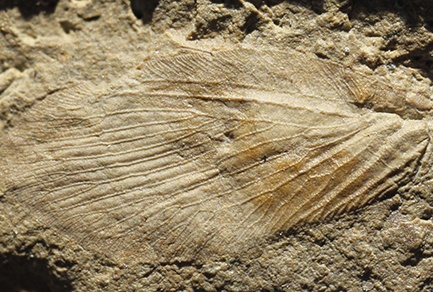Abstract
Ferganoberotha minutissima gen. et sp. nov. (Berothidae) is described from the Middle-Late Triassic Madygen Formation (Kyrgyzstan) based on an isolated forewing. This is the first species of Triassic Berothidae to be reported from Eurasia. Mesoberotha superbа (Riek, 1955), the type genus of Mesoberothidae from the Late Triassic of Australia, is redescribed and transferred to Berothidae, thereby making the former family a junior synonym of the latter.
References
- Aspöck, U., Aspöck H., Johnson, J.B., Donga, T.K. & Duell, P. (2020) Rhachiella malawica gen. nov., spec. nov. from Malawi—another beauty of the Afrotropics (Neuroptera: Rhachiberothidae). Zootaxa, 4808 (1), 131–140. https://doi.org/10.11646/zootaxa.4808.1.7
- Aspöck, U. & Randolf, S. (2014) Beaded lacewings—a pictorial identification key to the genera, their biogeographics and a phylogentic analysis (Insecta: Neuroptera: Berothidae). Deutsche Entomologische Zeitschrift, 61, 155–172. https://doi.org/10.3897/dez.61.8850
- Azar, D. & Nel, A. (2013) A new beaded lacewing from a new Lower Cretaceous amber outcrop in Lebanon (Neuroptera: Berothidae). In: Azar, D. Engel M.S., Jarzembowski E., Krogmann L., Nel A. & Santiago-Blay J. (Eds.), Insect Evolution in an Amberiferous and Stone Alphabet. Leiden, Brill, pp. 111–130. https://doi.org/10.1163/9789004210714_009
- Carpenter, F.M. (1991) A substitute name for the extinct genus Proberotha Riek (Neuroptera). Psyche, 98, 87–88. https://doi.org/10.1155/1991/45391
- Dobruskina, I.A. (1995) Keuper (Triassic) Flora from Middle Asia (Madygen, Southern Fergana). New Mexico Museum of Natural History and Science Bulletin, 5, 1–49.
- Dunn, R. (2018) Never Home Alone: From Microbes to Millipedes, Camel Crickets, and Honeybees, the Natural History of Where We Live. Basic Books, New York, New York, 336 pp.
- Engel, M.S. & Grimaldi, D.A. (2008) Diverse Neuropterida in Cretaceous amber, with particular reference to the paleofauna of Myanmar (Insecta). Nova Supplementa Entomologica, 20, 1–86.
- Engel, M.S., Grimaldi, D.A. & Krishna, K. (2009) Termites (Isoptera): Their Phylogeny, Classification, and Rise to Ecological Dominance. American Museum Novitates, 3650, 1–27. https://doi.org/10.1206/651.1
- Engel, M.S., Winterton, S.L. & Breitkreuz, L.C.V. (2018) Phylogeny and Evolution of Neuropterida: Where Have Wings of Lace Taken Us? Annual Review of Entomology, 63, 531–551. https://doi.org/10.1146/annurev-ento-020117-043127
- Grimaldi, D.A. (2000) A diverse fauna of Neuropterodea in amber from the Cretaceous of New Jersey. In: Grimaldi, D.A. (Ed.), Studies on Fossil in Amber, with Particular Reference to the Cretaceous of New Jersey. Backhuys Publishers, Leiden, pp. 259–303.
- Jepson, J.E., Makarkin, V.N. & Coram, R.A. (2012) Lacewings (Insecta: Neuroptera) from the Lower Cretaceous Purbeck Limestone Group of southern England. Cretaceous Research, 34, 31–47. https://doi.org/10.1016/j.cretres.2011.10.001
- Johnson, J.B. & Hagen, K.S. (1981) A neuropterous larva uses an allomone to attack termites. Nature, 289, 506–507. https://doi.org/10.1038/289506a0
- Khramov, A.V. (2015) Jurassic Beaded Lacewings (Insecta: Neuroptera: Berothidae) from Kazakhstan and Mongolia. Paleontological Journal, 49, 26–35. https://doi.org/10.1134/S0031030115010062
- Khramov, A.V. (2021) Osmyloberotha, an unusual new genus of beaded lacewings (Neuroptera: Berothidae) from Burmese amber. Zootaxa, 5060 (2), 245–249. https://doi.org/10.11646/zootaxa.5060.2.5
- Komatsu, T. (2014) Larvae of the Japanese termitophilous predator Isoscelipteron okamotonis (Neuroptera, Berothidae) use their mandibles and silk web to prey on termites. Insectes Sociaux, 61, 203–205. https://doi.org/10.1007/s00040-014-0346-6
- MacLeod, E.G. (1967) Studies on the Systematics of the Berothidae, Part I: A Redescription of the Genus Sphaeroberotha Navás, with a Critique of the Taxonomic Characters Used in the Berothinae (Neuroptera). Psyche, 74, 342–352. https://doi.org/10.1155/1967/79050
- Makarkin, V.N. (2015) A new genus of the mantispid-like Paraberothinae (Neuroptera: Berothidae) from Burmese amber, with special consideration of its probasitarsus spine-like setation. Zootaxa, 4007 (3), 327–342. https://doi.org/10.11646/zootaxa.4007.3.2
- Makarkin, V.N. (2017) An interesting new genus of Berothinae (Neuroptera: Berothidae) from the early Eocene Green River Formation, Colorado. Zootaxa, 4226 (4), 594–600. https://doi.org/10.11646/zootaxa.4226.4.9
- Makarkin, V.N., Yang, Q. & Ren, D. (2011) Two new species of Sinosmylites Hong (Neuroptera, Berothidae) from the Middle Jurassic of China, with notes on Mesoberothidae. ZooKeys, 130, 199–125. https://doi.org/10.3897/zookeys.130.1418
- McKellar, R.C. & Engel, M.S. (2009) A New Thorny Lacewing (Neuroptera: Rhachiberothidae) from Canadian Cretaceous Amber. Journal of the Kansas Entomological Society, 82, 114–121. https://doi.org/10.2317/JKES811.10.1
- Ponomarenko, A.G. (1995) Upper Liassic neuropterans (Insecta) from Lower Saxony, Germany. Russian Entomological Journal, 4, 73–89.
- Ponomarenko, A.G. & Shcherbakov, D.E. (2004) New Lacewings (Neuroptera) from the Terminal Permian and Basal Triassic of Siberia. Paleontological Journal, 38, S197–S203.
- Oswald, J.D. (2023) Bibliography of the Neuropterida. Lacewing Digital Library, Research Publication No. 2. Available from: http://lacewing.tamu.edu/Biblio/Main (accessed 10 May 2023)
- Riek, E.F. (1955) Fossil insects from the Triassic beds at Mt. Crosby, Queensland. Australian Journal of Zoology, 3, 654–690. https://doi.org/10.1071/ZO9550654
- Shi, Y., Zhang, W., Wang, B. & Liu, X. (2019) An unusual new genus and species of beaded lacewings (Neuroptera: Berothidae) from the mid-Cretaceous Burmese amber. Palaeoentomology, 2 (5), 453–464. https://doi.org/10.11646/palaeoentomology.2.5.9
- Voigt, S., Haubold, H., Meng, S., Krause, D., Buchantschenko, J., Ruckwied, K. & Goetz, A.E. (2006) Die Fossil-Lagerstätte Madygen: Ein Beitrag zur Geologie und Paläontologie der Madygen-Formation (Mittel-bis Ober-Trias, SW-Kirgisistan, Zentralasien). Hallesches Jahrbuch Für Geowissenschaften, 22, 85–119.
- Wedmann, S. & Makarkin, V.N. (2007) A new genus of Mantispidae (Insecta: Neuroptera) from the Eocene of Germany, with a review of the fossil record and palaeobiogeography of the family. Zoological Journal of the Linnean Society, 149, 701–716. https://doi.org/10.1111/j.1096-3642.2007.00273.x
- Wedmann, S., Makarkin, V.N., Weiterschan, T. & Hörnschemeyer, T. (2013) First fossil larvae of Berothidae (Neuroptera) from Baltic amber, with notes on the biology and termitophily of the family. Zootaxa, 3716 (2), 236–258. https://doi.org/10.11646/zootaxa.3716.2.6
- Whalley, P.E.S. (1980) Neuroptera (Insecta) in amber from the Lower Cretaceous of Lebanon. Bulletin of the British Museum of Natural History, Geology, 33, 157–164.
- Winterton, S.L., Hardy, N.B. & Wiegmann, B.M. (2010) On wings of lace: phylogeny and Bayesian divergence time estimates of Neuropterida (Insecta) based on morphological and molecular data. Systematic Entomology, 35, 349–378. https://doi.org/10.1111/j.1365-3113.2010.00521.x
- Yang, Q., Shi, C. & Ren, D. (2019) A new genus and species of berothids (Insecta, Neuroptera) from the Late Cretaceous Myanmar amber. ZooKeys, 864, 99–109. https://doi.org/10.3897/zookeys.864.35271
- Yang, Y., Li, H., Wang, B., Zhang, W. & Liu, X. (2020) New beaded lacewings (Neuroptera: Berothidae) from the mid-Cretaceous of Myanmar with specialized cephalic structures. Cretaceous Research, 108, 104348. https://doi.org/10.1016/j.cretres.2019.104348


